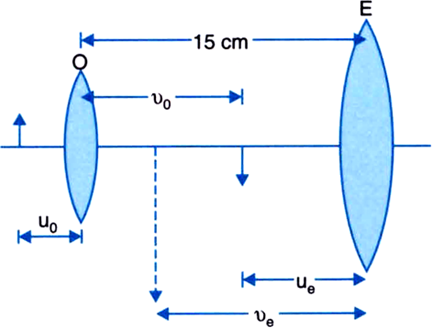Question
A compound microscope consists of an objective lens of focal length 2.0 cm and an eyepiece of focal length 6.25 cm separated by a distance of 15 cm. How far from the objective should an object be placed in order to obtain the final image at (a) the least distance of distinct vision (25 cm), and (b) at infinity? What is the magnifying power of the microscope in each case?
Solution
Given,
,

(a) For eyepiece,
Now, using the formula,
i.e., , which is the distance of the object from the eyepiece.
,

(a) For eyepiece,
Now, using the formula,
i.e., , which is the distance of the object from the eyepiece.
Now,
Distance of object from objective lens,
Therefore, for objective
Using the formula,
Magnifying power,
(b) If the image formed by the objective is in the focal plane of the eyepiece then, the final image will be formed at infinity.
object distance,
Image distance from objecrtive lens,
Now, using the formula, we have
which is the distance of the object from the objective lens.
Magnifying power M,
Distance of object from objective lens,
Therefore, for objective
Using the formula,
Magnifying power,
(b) If the image formed by the objective is in the focal plane of the eyepiece then, the final image will be formed at infinity.
object distance,
Image distance from objecrtive lens,
Now, using the formula, we have
which is the distance of the object from the objective lens.
Magnifying power M,





